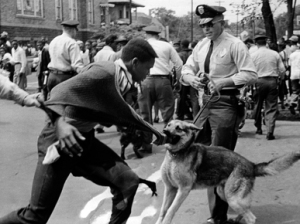 On Saturday, August 10, 1963, at a Black Unity Rally in Harlem, New York, Malcolm X made the following statement:
On Saturday, August 10, 1963, at a Black Unity Rally in Harlem, New York, Malcolm X made the following statement:
We want an immediate end to the police brutality and mob attack …that our people are confronted by every single day, every single week, every single month, every single year across the land.
The previous year, in April of 1962, one of Malcolm’s Muslim brothers, Ronald Stokes, was killed by police in Los Angeles. Even before that, in February of 1946, Issac Woodard, a World War II veteran, had his eyes gauged out by police in Georgia. In 1963, the same year of Malcolm’s speech, Birmingham, Alabama police officers turned their dogs and water hoses on to a group of peaceful marchers.
Fast forward to 1991, 28 years later, and we see Rodney King brutally beaten by  police officers in Los Angeles, California and subsequently go free even though their crime was caught on tape.
police officers in Los Angeles, California and subsequently go free even though their crime was caught on tape.
22 years later, in August of 2014, an unarmed teenager named Michael Brown, 18, was shot and killed by a police officer in Furguson, Missouri, and the police officer’s identity is under protection by the Furguson Police Department.
There is a grim pattern forming here. Police cannot seem keep their hands off black people more specifically black men. This has been going on for the better part of the 20th century and all of the 21st century and there has not been any sign of change yet.
 What is it about Black men that make them magnets for police violence? Could it be convenience? Michelle Alexander (2012), in her book The New Jim Crow, states that in the wake of the War on Drugs police officers have targeted black neighborhoods because of the likelihood of making arrests. Since there is a high police presence in black communities, it is more likely that a black man will have a run in with angry police officers.
What is it about Black men that make them magnets for police violence? Could it be convenience? Michelle Alexander (2012), in her book The New Jim Crow, states that in the wake of the War on Drugs police officers have targeted black neighborhoods because of the likelihood of making arrests. Since there is a high police presence in black communities, it is more likely that a black man will have a run in with angry police officers.
Or, could it be that black men have been criminalized? Alexander (2012) notes that research has shown that people have an implicit bias towards blacks especially following the War on Drugs media coverage on crack dealers, crack users and crack babies. According to Alexander “once blackness and crime, especially drug crime, became conflated in the public consciousness, the ‘criminalblackman’…would inevitably become the primary target for law enforcement” (p. 107).
The answer is that it is most likely a bit of both with some pure racism mixed in. All of these elements create the perfect storm for police brutality against black men. In truth, Malcolm X or anyone else could make the same statement today and it would be just as appropriate.
References
Alexander, M. (2012). The New Jim Crow: Mass Incarceration in the Age of Colorblindness. New York, NY: The New Press.
